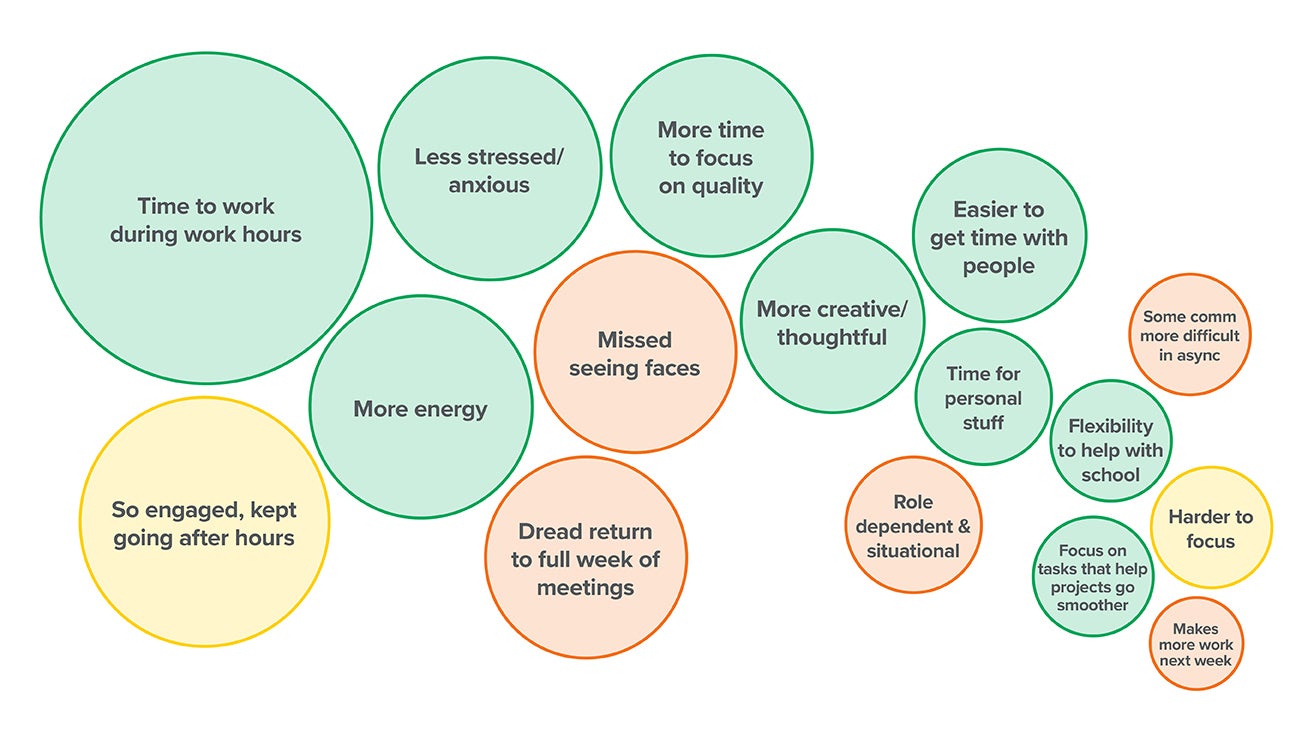Expel culture · 3 MIN READ · LAURA KOEHNE · DEC 8, 2020 · TAGS: leadership & management / Resource
Wait…what!? If you felt your stomach tighten in horror, followed quickly by a thrill up your spine at the idea of a whole week without meetings, you’re not alone.
Many Expletives felt the same as we prepared for our first Week Without Meetings in September. Eliminating all internal meetings for a week is a bold move, one designed to shock the system and make us more intentional about our meeting choices.
The experiment paid off by increasing flexibility, and giving us the space and energy we needed.
Want to try this at your company? Here are some lessons learned at Expel and tips for how your company can do it too.
Why a week without meetings
First, why’d we do it?
As school started, we’d heard from parents and caregivers that what was needed most was flexibility to do work at a time when they personally had fewer distractions, along with fewer meetings.
And we generally agreed that meeting-stuffed days, with hours on Zoom, were draining and left little time for individuals to do work and, even more important, work on strategic projects.
We wanted to change Expel’s meeting culture: Reducing the number of meetings (yes!) while improving the value of remaining meetings and encouraging more asynchronous collaboration.
Pro tip: Before scheduling a week without meetings, define specific objectives for your program.
It’s not enough to just stop meeting for a week. You’ll want to use the pause created by this event to support long-term behavior changes that meet your objectives.
Expel focused on these behaviors:
- Being intentional about the decision to have a meeting
- Making the meetings we do have more productive
- Using asynchronous collaboration to work together more flexibly
- Getting feedback on our meetings for continuous improvement
Here’s a quick decision tree we created to help employees decide whether or not they needed to schedule a meeting:
Meeting decision tree adapted from Real Life E Time Coaching and Training
But why actually stop meetings?
Eliminating all internal meetings for the whole week may seem drastic, but sometimes when you’re after urgent, collective behavior change you need a big gesture.
We wanted to catch attention immediately, to build awareness and have all Expletives experience the positive benefits of having fewer meetings first-hand, together.
Plus, we couldn’t very well schedule a meeting to talk about reducing meetings, could we? (Although, to be honest, those of us planning it met a lot while working out the details…go figure!)
How did you pull it off?
A Week Without Meetings gave us the “loud pause” we needed to slow down and become more selective about our meeting habits.
Here are the steps we took at Expel to prepare our people for a week without meetings (you can use these tips, too):
- Give several weeks advance notice so people can reorganize their schedules.
- Provide clear guidance and explicit permission for making decisions about which meetings to schedule and accept. (Our goal was to eliminate all internal meetings. Some meetings stayed: customers, of course, and a few managers met with job candidates or onboarded new hires. The point is to discern what can only be done in a meeting.)
- No meetings doesn’t mean no work. Depending on what you’re trying to do, there are plenty of ways to collaborate outside of meetings. Help your team use the tools available to them.
- Help managers prepare their teams for Week Without Meetings. Discuss strategies for communicating and maintaining forward momentum for the week.
Is that all?
Remember, the week itself is part of a behavior change initiative that started before the big event, and continues to this day.
Some other keys to our success include giving every Expel manager a chance to weigh in on the idea before it launched; preparing managers with talking points and tools to use with their teams; providing all Expletives with learning resources to support the changes (see a selection on sidebar) and continued reinforcement of key concepts by executives who share their “meeting mojo” with our company weekly.
Would you do it again?
Absolutely! In our first Week Without Meetings, many Expletives reported a noticeable increase in energy because they had more time to focus on getting work done.
Interestingly, a good number said they became more engaged in their work.
Overall we found the experience so beneficial, Expel just completed a second Week Without Meetings in November and plans to continue this tradition quarterly.
Here are some key themes from the feedback in September:
Week Without Meetings impact
If you’re going to implement your own Week Without Meetings, have a mechanism for gathering feedback asynchronously during that time. Share it at the start of the week and encourage people to post observations and ideas as they have them.
Expel uses a “hotwash” document that asks what’s going well, “meh” and badly. Derived from the hotwash, the bubbles above are keyed like a stoplight (green = good) and the size indicates the relative volume of comments by theme.
A final word
If an idea brings up a knee-jerk “No way!” follow it up with a “Why not?”Without that approach, Expel’s Week Without Meetings wouldn’t have made it off the drawing board.
Go ahead. Ask “Why not?”and see what happens when you ditch meetings for a week.
We can’t wait to hear how it goes. If you try it, send us a note – we want to hear about your experience.








